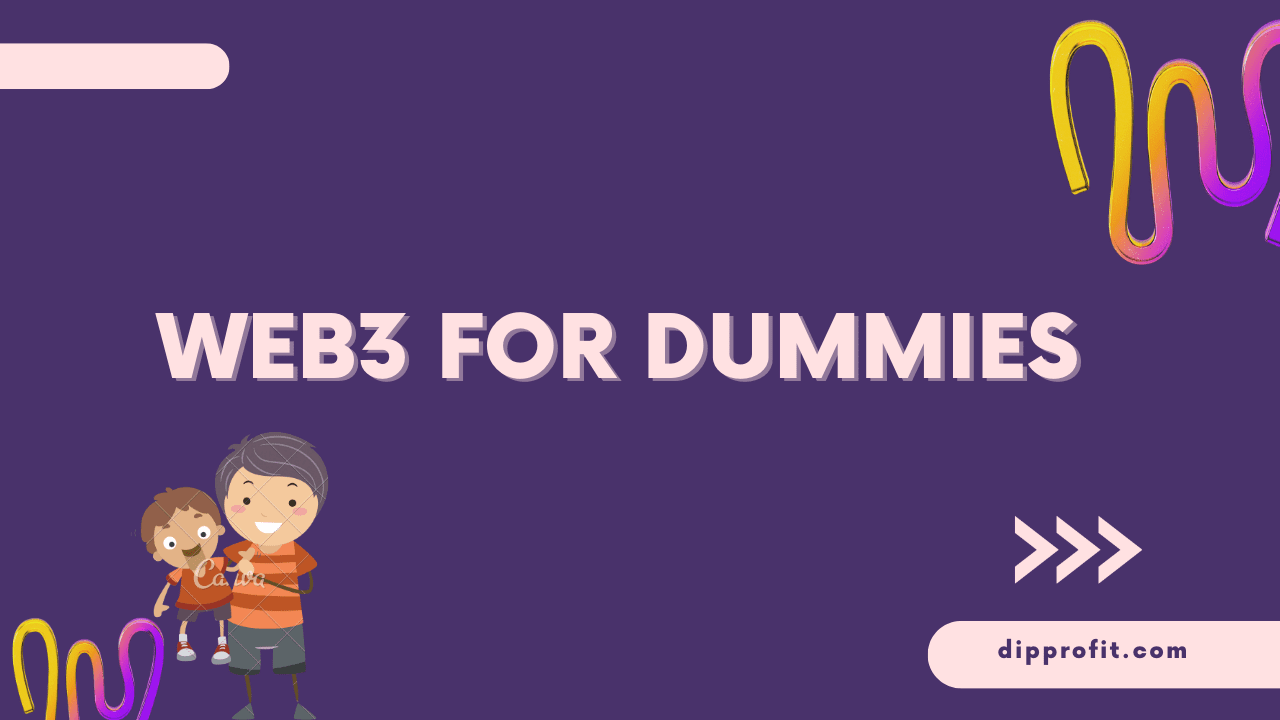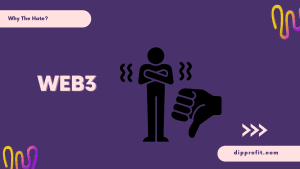
If you have ever wondered how you can watch funny cat videos or play games online, or even talk to a friend or a partner on the other side of the world, it’s all thanks to something called the internet.
The internet is like a big, magical network of computers that lets people connect with each other and share information, just like how you share toys with your friends.
Guess what? The Internet is getting even more exciting!
There’s something called Web3 that’s going to make it even better. Web3 is like a new version of the Internet. It’s like when you get a refurbished car that does even more better things than you expected.
Web3 for Dummies: What is Web2?
The Internet has come a long way since its early days.
Right now, we’re using something called Web2. It is called the second version of the internet.
With Web2, we can do lots of cool things like sending messages to our friends, watching videos, and playing games which is more dynamic compared to the earlier version.
In Web2, you can do a lot more than just read and look at things. You can comment on posts, share pictures and videos, and even create your own content on websites and social media platforms.
Web2 is all about connecting people and sharing information. You can use social media websites like Facebook, Instagram, and Twitter to stay in touch with your friends and family.
You can also watch videos on platforms like YouTube or stream your favorite shows on Netflix. Web2 allows you to communicate, collaborate, and be a part of online communities.
One of the great things about Web2 is that it’s easy to use. You don’t need to be a computer expert to navigate through websites or interact with others online. It has become a part of our everyday lives, whether we’re searching for information, shopping online, or just having fun.
In spite of all of its advantages, Web2 also has its limitations.
It is controlled by a few big companies, and they have the power to decide what we see and how our data is used.
Sometimes, it can feel like our online experiences are being influenced by these companies.
It’s awesome, but there’s something even more amazing on the horizon.
See also: A Look at the Future of Decentralized Networks
Web3 for Dummies: Introducing Web3
Before we dive into Web3, let’s take a quick trip down memory lane.
The first version of the Internet, known as Web1, was a digital library where you could read and access information. Then came Web2, which introduced interactive features and social media platforms that allowed us to connect and share content.
Now, it’s time for Web3 to take the stage.
Web3 is all about giving power back to the users where instead of relying on big companies to control our data and online experiences, Web3 puts us in charge with something called Decentralization.
At the heart of Web3 is blockchain technology.
Think of it as a super secure and transparent digital ledger that keeps track of information. With blockchain, we can create decentralized systems where no single entity or organization has total control.
Instead of having one big company in charge, Web3 is shared by lots of different people. It is all about being fair and equal to every single user irrespective of any socially defined standards.
Secondly, privacy takes center stage.
With the increasing concerns around data breaches and surveillance, Web3 technologies aim to protect your privacy and give you the freedom to navigate the online world without constant scrutiny.
It’s like having your own private sanctuary on the Internet where you can be yourself without worrying about being watched.
Thirdly, true ownership and digital assets.
In Web3, you have the power to truly own your digital assets. But what exactly does that mean?
Imagine you have a special toy that belongs only to you. You can play with it, show it to your friends, and decide what to do with it. Similarly, in Web3, you can own unique digital items, like virtual pets, artwork, or even virtual land. These items are called non-fungible tokens (NFTs). They are like digital certificates that prove you are the rightful owner of something special in the digital world.
With true ownership, you can buy, sell, and trade digital assets freely, just like you would with physical items. It’s like having your very own digital treasure chest full of things that are uniquely yours.
That’s what Web3 is all about!
Web3 for Dummies: How is Web3 Different from Web2?
Web3 and Web2 represent two distinct phases in the evolution of the Internet, each with its own characteristics and implications. Let’s explore how Web3 is different from Web2:

- Centralization vs. Decentralization: Web2 is characterized by a centralized model where a few big companies control and govern the platforms and services. In contrast, Web3 embraces decentralization, where power is distributed among a network of participants. This allows for greater transparency, resilience, and user empowerment.
- Ownership of Data: In Web2, users often have limited control over their personal data, which is collected and controlled by companies. Web3 emphasizes data ownership, giving users the ability to control and manage their own data. It shifts the paradigm to a user-centric approach, where individuals have the authority to decide how their data is used.
- Privacy and Security: Web2 platforms rely on centralized systems that may raise concerns about privacy and security. Web3, on the other hand, prioritizes privacy and security through cryptographic protocols and decentralized architectures. It provides users with greater control over their digital identity and protects them from unauthorized access or surveillance.
- Monetization and Value Creation: In Web2, the majority of the value generated from user-generated content goes to platform owners and advertisers. Web3 introduces new models for value creation and monetization. With the use of cryptocurrencies and tokens, creators can receive direct support and financial rewards from their audience, fostering a more equitable system.
- Collaboration and Community Governance: Web2 platforms are typically controlled by a centralized authority, limiting the influence of users in decision-making processes. Web3 platforms encourage collaboration and community governance, where users have a say in the development and governance of the platforms they use. This allows for a more inclusive and participatory environment.
- Interoperability and Open Standards: Web3 embraces interoperability and open standards, enabling different applications and platforms to seamlessly interact and share information. This allows for the creation of decentralized applications (DApps) that can integrate and communicate with each other, fostering innovation and synergy between different projects.
- Trust and Transparency: Web2 platforms rely on trust in central authorities to ensure fair transactions and interactions. In Web3, trust is established through decentralized consensus mechanisms and smart contracts, reducing the reliance on intermediaries. Transactions and activities on the blockchain are transparent and verifiable by anyone, promoting trust and accountability.
See also: How To Make Money With Web3 in 2023
Web3 for Dummies: Applications in our Everyday Life
Web3 can be used for lots of things.

For example, you can own digital pets and trade them with your friends. Or you can create and sell your own artwork online. You can even use Web3 to raise money for good causes, like helping sick animals or saving the environment.
Here are more examples of web3 applications in our everyday life.
- Decentralized Finance (DeFi): DeFi platforms enable users to access financial services without relying on traditional intermediaries like banks. They allow for lending, borrowing, trading, and earning interest on cryptocurrencies. Examples include Compound, Aave, and Uniswap.
- Non-Fungible Tokens (NFTs): NFTs are unique digital assets that represent the ownership of a specific item, such as artwork, collectibles, or music. They use blockchain technology to prove authenticity and ownership. To find more about NFTs visit platforms like OpenSea, Rarible, and NBA Top Shot where they are traded.
- Decentralized Social Networks: These platforms aim to provide social networking services without the central control and data ownership issues seen in traditional social media platforms. Examples include platforms like Mastodon, Peepeth, and Steemit.
- Decentralized Storage: These platforms offer secure and decentralized storage solutions where users can store their data without relying on centralized servers. Examples are Filecoin and Storj
- Blockchain-Based Gaming: Web3 introduces gaming features that apply blockchain technology in-game and allow players to truly own in-game assets and participate in decentralized virtual economies and governance systems. Examples are Axie Infinity and CryptoKitties.
- Decentralized Identity (DID): DID platforms enable users to have control over their digital identities and personal data. They allow for secure and verifiable identity management without relying on centralized authorities. Some of them are uPort, Sovrin, and Civic.
- Decentralized Exchanges (DEX): DEX platforms allow peer-to-peer cryptocurrency trading without the need for intermediaries. They operate on decentralized networks and utilize smart contracts to enable secure and transparent transactions. Examples are PancakeSwap, SushiSwap, and Balancer.
See also: The Top Decentralized Applications in 2023 and how they work
Web3 for Dummies: Why The Hate?

Web3 might sound amazing, but it’s not all rainbows and unicorns. There are a few things that make some people scratch their heads. Let’s take a look:
I can agree with you that sometimes, it can be a bit tricky to understand. It’s like learning a new game or a new language. Some people find it hard to keep up with all the new terms and concepts.
Secondly, just like in the real world, there are some not-so-nice people in Web3 too.
Scams and fraud are unfortunate aspects that exist not only in the physical world but also in the digital realm of Web3. So It’s important to be aware of these bad guys and know how to protect ourselves.
There are individuals who may use web3 technologies to try to trick others for their own gain. Usually, they might create fake websites or apps that look real but are actually designed to steal people’s personal information or money.
They may also promote fraudulent investment opportunities that promise big returns but are, in reality, scams.
To protect yourself from scams and fraud, stay vigilant, verify the authenticity of any site, and use reputable platforms to conduct transactions and transfer private details.
This brings us to the next issue about web3. Who’s in charge?
In Web3, things are not as organized as they are in Web2.
The decentralized nature of Web3 has brought a lot of challenges and questions about governance and accountability.
And since there is no central authority, it can sometimes be unclear who is responsible for resolving disputes, enforcing rules, and making decisions that impact the community.
To address these concerns, various approaches are being explored within the Web3 community. One approach is the concept of decentralized autonomous organizations (DAOs), which are organizations governed by smart contracts and operated by community members.
DAOs aim to give stakeholders a say in decision-making processes through voting mechanisms and transparent governance structures.
Finally, the fear of change.
It’s something many of us can relate to. Sometimes, when something new comes along, we can feel a little scared or unsure. We might want to hold onto what we already know and are comfortable with.
In the case of Web3, some people might be hesitant to embrace it because they’re used to Web2, which is the internet they are familiar with.
Web3 brings with it amazing possibilities like decentralization, privacy, and true ownership. So, even though it’s natural to feel a little scared of change, let’s remember that sometimes the best things in life come from taking a leap into the unknown.
Web3 has the potential to empower us, protect our privacy, and unlock new opportunities that we never knew were possible.
See also: Did you know about these benefits of Web3?
Web3 for Dummies: Getting Started

Now that you have a basic understanding of Web3, it’s time to put on your explorer’s hat and start your journey! Here are a few steps to get you started:
- Set up your digital wallet: Download and install any wallet, create an account, and securely store your recovery phrase. This will be your key to accessing your funds that will be stored on the blockchain.
- Get some digital assets: Purchase or earn some cryptocurrencies like Ether (ETH) to fund your adventures and acquire unique digital items. To earn cryptocurrency, sign up for a web3 game and complete tasks to get rewards.
- Start exploring dApps: Visit platforms like OpenSea, Rarible, or Decentraland to discover and engage with the vibrant Web3 community. On these marketplaces, you can buy digital artwork, and trade collectibles for a token.
- Join communities: Find and participate in Web3 communities that align with your interests. Connect with like-minded individuals and learn from their experiences.
- Stay curious: Keep learning and exploring new dApps, projects, and advancements in the Web3 space with Dipprofit. There’s always something exciting happening, and being curious will help you stay ahead of the game.
Final Words
Web3 is a game-changer that puts power back into the hands of users. It breaks away from the centralized model, focusing on decentralization, data ownership, privacy, and transparency.
With Web3, you can have more control over your online presence, support content creators directly, collaborate with global communities, and be part of an innovative and inclusive Internet landscape.
Don’t you think it’s time to embrace Web3 and shape the digital future?